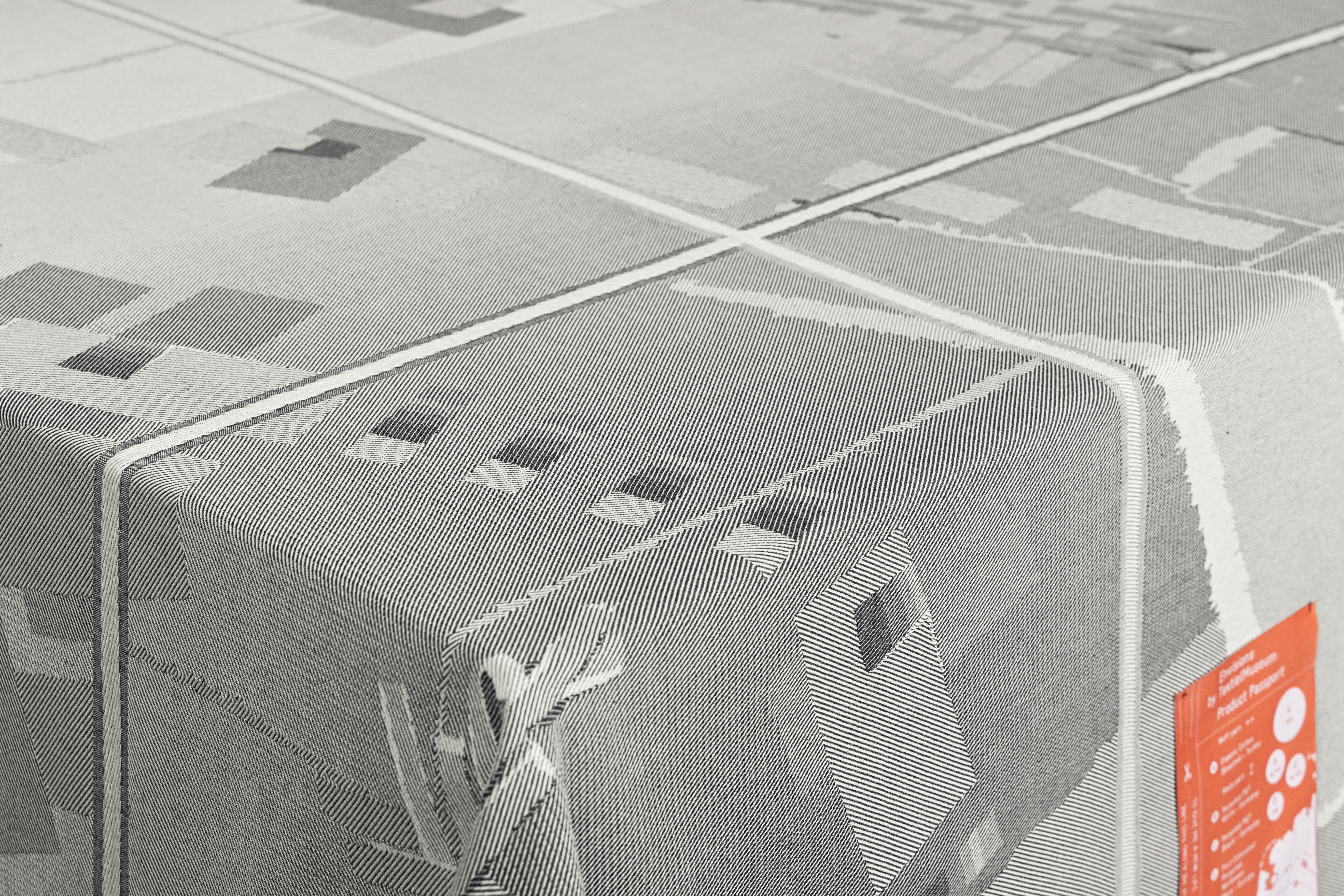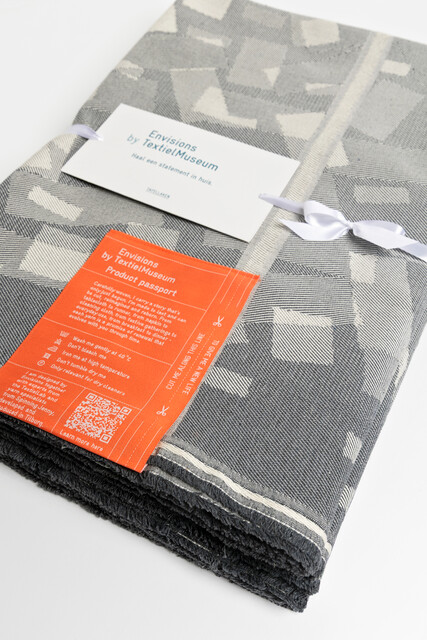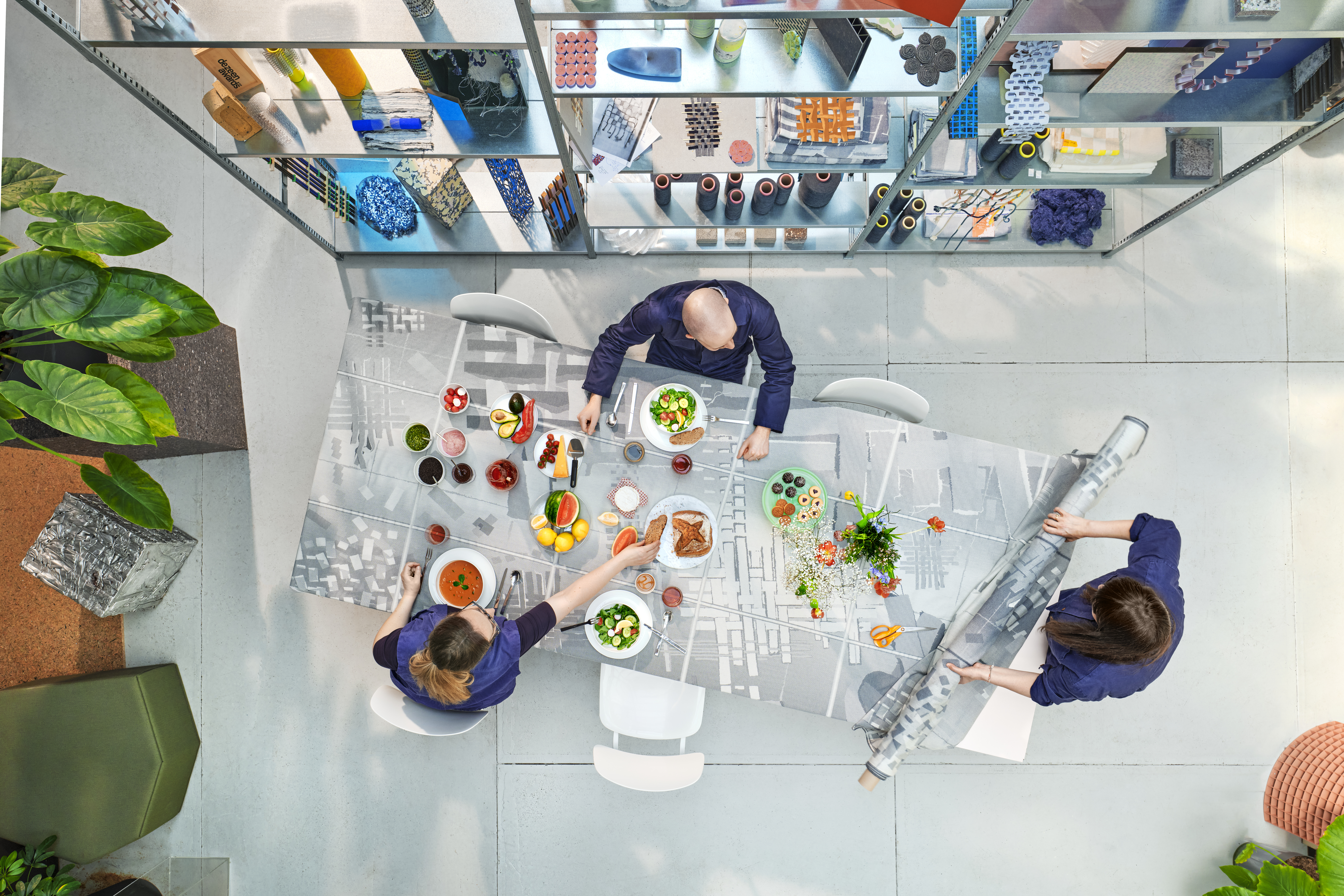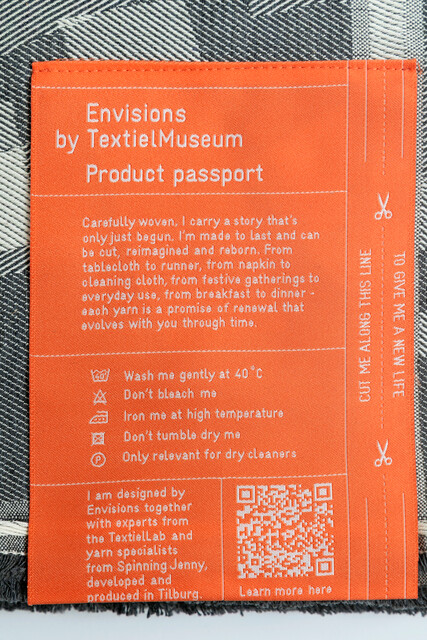
New product label shows the origin of the materials used
14 October 2025
A new product has been added to the TextielMuseum’s own line. ‘Re_Work’ is a tablecloth that demonstrates just how sustainable it can be in 2025. It was designed by the design collective Envisions, who attached a striking label – not just a small tag with care instructions, but a full product passport.

Photo: Josefina Eikenaar
The commission for the new by TextielMuseum product went to the design collective Envisions, who had previously been responsible for the exhibition design of four Makersgeheimen shows. This time, there was a specific request: the focus had to be on making the production process more sustainable. “The designers at Envisions work very investigatively; they are really good at deconstructing and rebuilding,” says Lise Brunt, materials advisor at the TextielLab.
The tablecloth that emerged from this sustainable ‘reset’ has been given the fitting name Re_Work. It was recently launched in Eindhoven during Dutch Design Week and is now available for purchase at the museum shop in Tilburg. It can also be seen throughout the year as part of the exhibition Setting the Table Sustainably in the Damastweverij behind the shop.
Re_Work
Re_Work demonstrates in various ways just how sustainable production can be in 2025. The project began with a joint brainstorming session about what sustainability actually means in a textile context, and what the most important requirements are. The origin and reuse of materials were given high priority.
The tablecloth is ultimately made from discarded workwear and PET bottles that were recycled and processed relatively close to the lab. A recycling company in Germany converted old uniforms and plastic bottles into fibres, which the spinning mill Spinning Jenny in Nijverdal spun into high-quality yarns. The yarns only had to travel 150 km to reach the TextielLab, where they were woven on a warp of GOTS-certified organic cotton – a new unbleached warp, slightly creamier than white – which the TextielLab now intends to use for all label products. Finally, the tablecloths were finished on site and are then sold directly in the shop.

Foto: Ronald Smits
Sustainable damask
The design of the tablecloth is based on the historic diaper damask from the TextielMuseum’s collection: a simple form of damask in which twill weaves reveal patterns. This traditionally checkered household textile was cheaper than regular damask but was just as durable, lasting for years. Envisions enlarged the twill weaves and used them as the starting point for the design. In this contemporary interpretation of traditional tableware, sustainability is approached from multiple angles. Not only was un-dyed recycled yarn from a Dutch micro-spinning mill chosen, but consideration was also given to the intended use and lifespan of the product.
“We didn’t design this tablecloth to be brought out only for special occasions,” says Sanne Schuurman of Envisions. “It is intended for everyday use.” Building on the historic damask, which was often repurposed as a cleaning cloth once its decorative purpose was over, special cutting lines were added. These give the cloth an appealing ‘afterlife’: after serving as a tablecloth, it can be cut into a stack of napkins or cleaning cloths without fraying.
Big label
To communicate all these sustainable features to consumers, a brand-new label has been developed and attached to the tablecloth. It’s not a small white tag you want to remove immediately, but a striking red passport-sized label with an attractive graphic design.
“We deliberately chose to make it stand out,” says Lise Brunt. “This label is ‘in your face’ so you immediately find the information that matters.”
With this project, the TextielLab is already preparing for the mandatory EU Digital Product Passport (DPP), which will be required from 2027. The DPP uses a unique identification code to give consumers online insight into the production chain. The advantage of Envisions’ passport-style label is that it conveys a lot of information without needing to check your phone at the table. The finely woven infographics show which materials are in the cloth and where they come from. At a glance, it’s clear that this tablecloth has not travelled far before reaching the consumer. The label also includes a short text explaining the design concept, as well as a QR code for more information via the TextielMuseum webshop.

Photo: Josefina Eikenaar
Recycled and recyclable
This first product passport, in the form of a label, serves as a test case for all future products created in the lab for by TextielMuseum. With the introduction of the label, the TextielMuseum and TextielLab provide insight into the ecological impact of their products and aim to show which steps are being taken to reduce that impact.
“We are transparent about where it was made, who was involved, and how it can be reused,” says Brunt. “This also anticipates the EU’s Extended Producer Responsibility (EPR) guidelines for textiles. These European rules will soon ensure that producers take greater responsibility for what they manufacture, the percentage of recycled material they use, and the recyclability of their products.”
How does sustainability feel?
Working with recycled yarns sounds easier than it is: these yarns differ in colour and quality, and are often slightly coarser. During the preparatory phase, various yarns from small Dutch spinning mills were tested.
“We were determined to work with locally recycled yarn that met the quality standards of our label and that didn’t need to be re-dyed,” says Brunt. This search led them to Spinning Jenny, which proved best suited for this production. Sanne Schuurman explains that they had to make quite a few adjustments during the design process:
“Truly sustainable production imposes limitations on design. For example, we initially planned to use a lot more colour, and the texture is slightly different from what you might expect from a tablecloth.”
You can experience how sustainability feels yourself this week at the Klokgebouw in Strijp-S, or simply in the TextielMuseum shop. Perhaps it’s perfect for your own table: the most sustainable Dutch Design tablecloth currently available.
The tablecloth is on display until 26 October at Envisions’ presentation in the Klokgebouw in Eindhoven, and until 10 January 2027 at the TextielMuseum Tilburg in the exhibition Setting the table sustainably. It is available for purchase in the museum shop and via the online webshop.
Text: Willemijn de Jonge
Meet the artists
1 / 1
